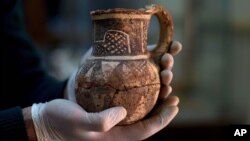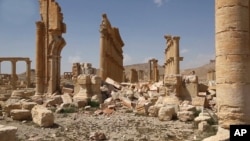The Islamic State (IS) may have raised as much as $100 million by digging up and selling priceless antiquities from territory it controls, according to experts consulted by a U.S. congressional panel.
At a Tuesday hearing of the House Task Force to Investigate Terrorism Financing, experts said IS is the wealthiest terror group operating today. The illegal relic trade is a "key source" of some of that wealth, according to Lawrence Schindell who tracks art sales and money laundering in the art world and heads ARIS Title Insurance Corporation.
Looting of historic sites was going on before IS took over, but witnesses said IS "institutionalized” the activity and operates on an “industrial” scale. IS is organizing an increasingly sophisticated, systematic, destructive and profitable campaign to plunder some of the thousands of archeological sites in areas of Iraq and Syria.
Professor Amr Al-Azm of Shawnee State University in Ohio, says IS sees cultural heritage items as resources to be exploited for revenue, in much the same way as oil.
WATCH: Looting Means Millions of Dollars for IS
Yaya Fanusie of the Center on Sanctions and Illicit Finance, says the illegal relics trade is not as lucrative as the sale of oil by IS. But he says the relic trade requires less capital investment and can provide work badly needed by residents in areas where the economy is disrupted by conflict. IS also licenses relic hunters in areas under its control, taxes their finds, and is increasingly directly involved in finding and selling these goods.
Fanusie says the relic trade is not likely to be disrupted by air strikes that have hurt revenue from oil operations. The relics trade is also easier to foist on populations under IS control, than kidnapping, extortion, confiscation, or taxes which also produce revenue.
IS is well known for destroying key historic relics that do not confirm to its ideology, actions that sparked global outrage after assaults on historic relics in Palmyra and elsewhere. Experts say spectacular acts of vandalism by IS are a propaganda tool intended to show the world the international community is powerless to stop them. Witnesses say what is less known is that IS tends to destroy buildings or artifacts that are too large to move, while earning millions by selling many smaller items.
Experts say IS methods of collecting relics are destructive, and sometimes employ bulldozers and trucks. Archeologists use trowels and paint brushes to carefully unearth relics.
Patty Gerstenblith of the art preservation group Blue Shield says scholars glean great insight from the location and surroundings of their historic finds. She says the crude actions by IS closes these windows into history forever.
Gerstenblith says freshly looted antiquities are the “perfect vehicle” for money laundering and other illegal activities connected with terrorism. According to Schindell, that is because artwork is a “high-value highly-portable asset traded in a market defined by discretion.”
Several hearing witnesses discussed better tracking of artworks, stronger laws regulating sales of relics harvested in conflict zones, better coordination between financial regulators and law enforcement, and relevant training for intelligence and other agencies.
Fanusie says learning more about IS relic operations can give new insight into the terror group's operations, leadership, intentions, and vulnerabilities. He called for Washington to step up enforcement and penalties for relic buyers
Schindell says the looting and destruction of the global historic heritage will only stop when smarter enforcement makes selling plundered pieces of history less profitable.












